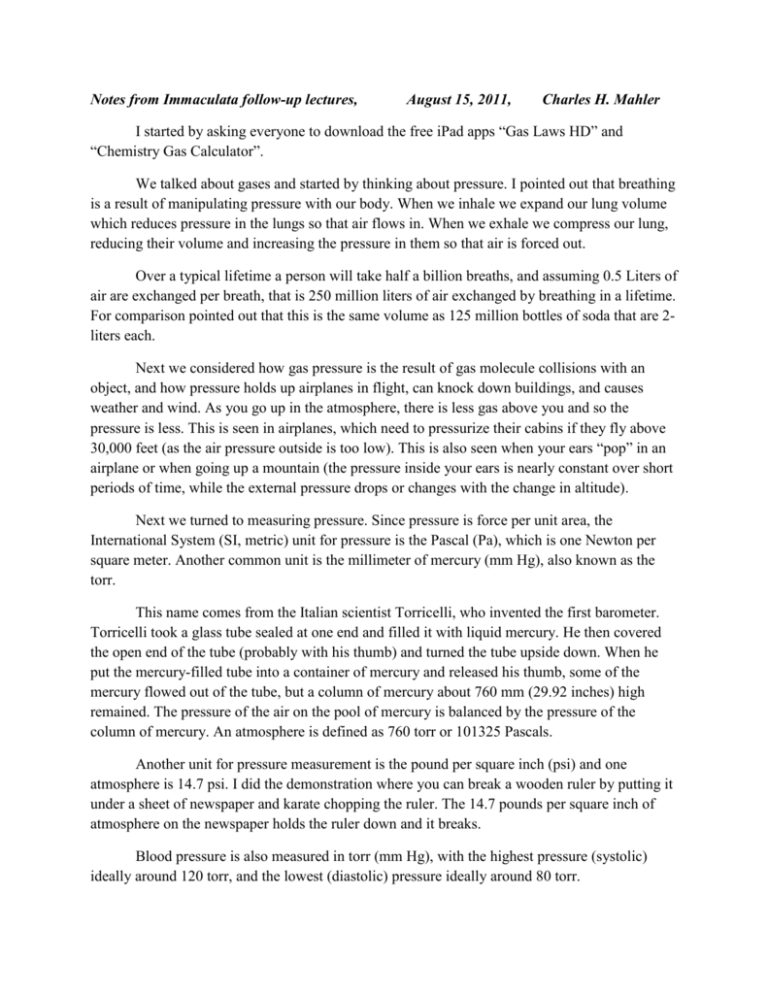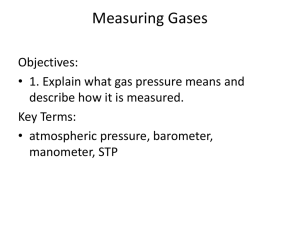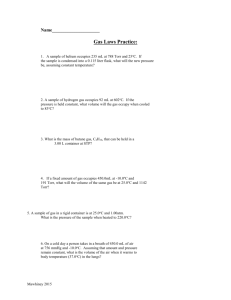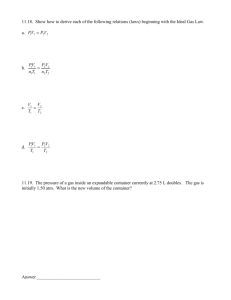Notes from Immaculata followup 8 15 2011
advertisement

Notes from Immaculata follow-up lectures, August 15, 2011, Charles H. Mahler I started by asking everyone to download the free iPad apps “Gas Laws HD” and “Chemistry Gas Calculator”. We talked about gases and started by thinking about pressure. I pointed out that breathing is a result of manipulating pressure with our body. When we inhale we expand our lung volume which reduces pressure in the lungs so that air flows in. When we exhale we compress our lung, reducing their volume and increasing the pressure in them so that air is forced out. Over a typical lifetime a person will take half a billion breaths, and assuming 0.5 Liters of air are exchanged per breath, that is 250 million liters of air exchanged by breathing in a lifetime. For comparison pointed out that this is the same volume as 125 million bottles of soda that are 2liters each. Next we considered how gas pressure is the result of gas molecule collisions with an object, and how pressure holds up airplanes in flight, can knock down buildings, and causes weather and wind. As you go up in the atmosphere, there is less gas above you and so the pressure is less. This is seen in airplanes, which need to pressurize their cabins if they fly above 30,000 feet (as the air pressure outside is too low). This is also seen when your ears “pop” in an airplane or when going up a mountain (the pressure inside your ears is nearly constant over short periods of time, while the external pressure drops or changes with the change in altitude). Next we turned to measuring pressure. Since pressure is force per unit area, the International System (SI, metric) unit for pressure is the Pascal (Pa), which is one Newton per square meter. Another common unit is the millimeter of mercury (mm Hg), also known as the torr. This name comes from the Italian scientist Torricelli, who invented the first barometer. Torricelli took a glass tube sealed at one end and filled it with liquid mercury. He then covered the open end of the tube (probably with his thumb) and turned the tube upside down. When he put the mercury-filled tube into a container of mercury and released his thumb, some of the mercury flowed out of the tube, but a column of mercury about 760 mm (29.92 inches) high remained. The pressure of the air on the pool of mercury is balanced by the pressure of the column of mercury. An atmosphere is defined as 760 torr or 101325 Pascals. Another unit for pressure measurement is the pound per square inch (psi) and one atmosphere is 14.7 psi. I did the demonstration where you can break a wooden ruler by putting it under a sheet of newspaper and karate chopping the ruler. The 14.7 pounds per square inch of atmosphere on the newspaper holds the ruler down and it breaks. Blood pressure is also measured in torr (mm Hg), with the highest pressure (systolic) ideally around 120 torr, and the lowest (diastolic) pressure ideally around 80 torr. We also talked about the open tube manometer as a way to measure the pressure of a gas in a container attached to the manometer. If the pressure in the container is greater than atmospheric, the fluid in the U-shaped manometer is lower on the side attached to the container (and higher on the side open to the atmosphere). If the pressure is lower than atmospheric in the container, then the fluid in the U-shaped manometer tube is higher on the side attached to the container and lower on the side open to the atmosphere. Reviewed Boyle’s Law that volume of a gas is directly proportional to the inverse of pressure, usually written as P1V1 = P2V2 or PV = constant. We noted that temperature and the amount of substance (moles) are kept constant. We looked at how pressure affects divers. Every 10 meters further down in water a diver goes, the diver experiences one more atmosphere of pressure. A diver’s regulator delivers gas at a pressure equal to the external pressure the diver experiences so that the diver can breathe at the greater pressure experienced underwater. For example, at 20 meters below the surface, a diver would experience a pressure of three atmospheres (1 atm from the air, 1 atm for the first 10 m of water, and 1 atm for the second 10 m of water). When divers ascend, they have to go up slowly and never hold their breath. Breathing continuously allows the air pressure to equalize in the lungs. I asked the class would a 10-foot long snorkel work to allow a person to breathe underwater? It would not, as the person would experience a pressure greater than atmospheric and would not be able to inhale the lower pressure atmosphere at the other end of the snorkel. Next we talked about Charles’ Law that the volume of a gas is directly proportional to the absolute temperature, usually written as V1/T1 = V2/T2 or V/T = constant. We noted that pressure and amount of substance (moles) are kept constant. The absolute temperature is measured in the Kelvin temperature scale. Zero Kelvin is –273.15 °C and is the lowest possible temperature, though it cannot be reached according to the laws of thermodynamics. Practical examples of Charles’ Law include warm air expanding, becoming less dense and rising (floating). So hot air balloons float, or the second story of a house usually is warmer than the first story (since hot air rises). Another example is a balloon shrinking as it is cooled in liquid nitrogen. At this point we stopped and did the iPad “Gas Laws HD” app to look at Boyle’s and Charles’ Laws and plotted the data to see these relationships graphically. Next we looked at Avogadro’s Law that the volume of a gas is directly proportional to the amount of substance (number of moles), usually written as V1/n1 = V2/n2 or V/n = constant. We noted that pressure and volume are kept constant. This is why you can’t put dry ice in a sealed container (it will explode as the number of moles of gas increase). Next we moved to the Ideal Gas Law, PV = nRT, and saw that we can combine Boyle’s, Charles’ and Avogadro’s Laws to get it. Initially we can say that the volume is directly proportional to the number of moles times the absolute temperature, with this product divided by the pressure. If we add the gas constant, R, it becomes the equation given above. Noted that all of the gas laws mentioned can be derived from the Ideal Gas Law, and that even laws we have not discussed, like Gay-Lussac’s Law can be derived from PV = nRT. Gay-Lussac’s Law is that the pressure of a gas is directly proportional to the absolute temperature, usually written as P1/T1 = P2/T2 or P/T = constant. At this point we stopped and did the P – T – V sticks demonstration. There is a wooden “popsicle stick” with the letters P (left end), T (center), and V (right end) written on it. Hold the stick on the variable held constant, so for example if you are looking at Boyle’s Law, hold the stick at the T. If you raise P, V goes down (and vice versa). Next we talked about molar volume, which is 22.4 liters for one mole of gas at 273 K and 1 atm. Since density is mass over volume (d = m/v), we can look at molar mass over molar volume to find density too. Since molar volume is constant for a gas behaving ideally, we can calculate the density. So helium (He) has a molar mass of 4.00 g/mol and a density of 0.179 g/L at 273 K and 1 atm. Nitrogen gas has a molar mass of 28.02 g/mol and a density of 1.25 g/L, so we can see why He balloons float so well in air (which is 80% nitrogen) – the He balloons are much lense dense than the surrounding air. Hydrogen gas (2 g/mol) is even better than He. Next we looked at Dalton’s Law of Partial Pressures, which says that the total pressure of a mixture of gases is just the sum of pressure of each gas. Air is a mixture of gases. Dry air is about 78% nitrogen by volume, 21% oxygen, 0.9% argon, and about 0.04% carbon dioxide. Next we looked at divers again and how they or anyone dealing with air at high pressures will suffer from oxygen toxicity if the partial pressure of oxygen is greater than 1.4 atm, nitrogen narcosis (or rapture of the deep) if the partial pressure of nitrogen is greater than 4 atm. Some ill people get pure oxygen as their lungs are not working as well. Some people with wounds that are not healing are put in hyperbaric chambers with high oxygen pressure to promote healing. High pressure can also lead to the bends, where nitrogen dissolves in the blood stream and can come out as bubbles as pressure drops. Next we focused on the small amount of carbon dioxide in the air (0.04%). In 1649, Jean Baptiste von Helmont planted a willow tree sapling in soil he had dried and weighed previously. For five years he added only water, made sure the tree got sunlight, and kept the container from losing soil. After five years he removed the tree, dried the soil, and weighed everything. The tree gained 164 pounds, the dried soil had lost only a few ounces. While some of the mass gain in the tree came from the water (and a tiny amount from the soil), much of the mass gain came from the carbon dioxide. Finally we looked at the kinetic (molecular) theory of gases. While we derived the ideal gas law from macroscopic properties of gases (pressure, volume, temperature, and moles), it can also be derived from considering the properties of molecules. The kinetic theory is based on three postulates. The first postulate is that the size of gas atoms or molecules is negligibly small, so they have mass but no volume. If an argon atom were the size of a golf ball, the next nearest argon would be about four feet away. The second postulate is that the atoms or molecules in a gas are in ceaseless random motion; the average kinetic energy of a gas is directly proportional to the absolute temperature (in Kelvin). Helium atoms move faster than argon. The third postulate is that the collisions between atoms or molecules are completely elastic – they can exchange energy in a collision but there is no overall loss of energy. This basically assumes ideal gases have no attractive or repulsive forces between atoms or molecules. We can see how pressure arises from collisions of the atoms or molecules with the walls of the container. If the volume of the container is decreased, the pressure increases as there are more collisions. Finally we noted that real gases have a small volume (so a mole of water occupies 18 milliliters as a liquid and 22.4 liters as a gas at 273 K and 1 atm), and have attractive and repulsive forces between molecules, depending. So if we cool a gas enough, it will liquefy as the attractive forces make the molecules stick together in a liquid. Or if we increase the pressure enough a gas will also liquefy as volume decreases to the point where the gas molecules are sticking together. The ideal gas law is a limiting law and applies to gases as long as they are not in extremes of pressure or temperature.






